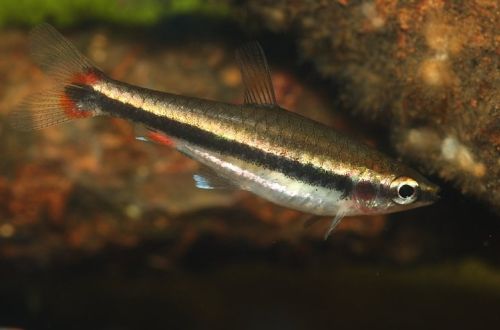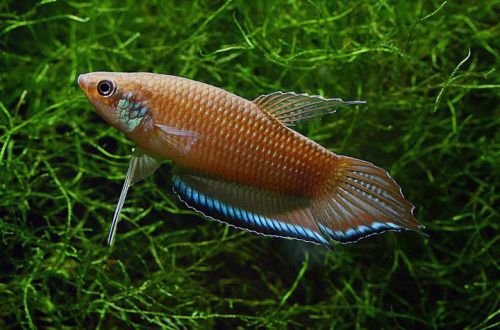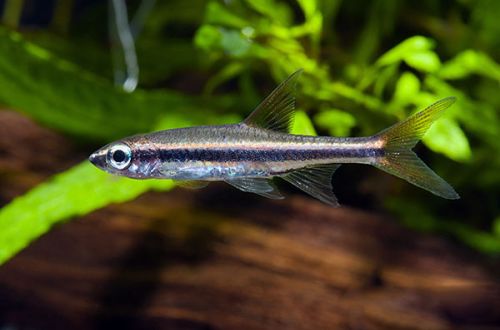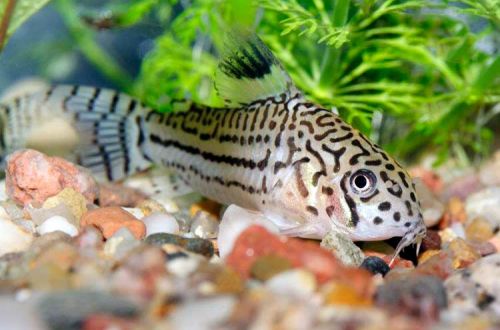
Beckford’s nannostome
Beckford’s nannostome, scientific name Nannostomus beckfordi, belongs to the Lebiasinidae family. A miniature moving fish rarely exceeding 4 cm in size. A small flock will be a great addition to a tropical aquarium. Often used as neighbors for larger and more beautiful fish, such as Discus.

Habitat
Widespread in the lower Amazon River basin (South America) on the territory of modern Brazil, Venezuela, Guiana, Suriname. They live in small rivers and streams with a weak current, in wetlands. Prefer areas with dense aquatic vegetation, flooded trees, shrubs.
Description
A low body, elongated in length, females are fuller. A distinctive feature is the absence of an adipose fin. The coloration is brownish-pinkish with a longitudinal dark stripe in the lower part of the body. The females are paler. There are several related species that are very similar to Beckford’s Nannostus, but unlike it, they have several dark longitudinal stripes throughout the body.
Food
In the wild, they feed on small invertebrates and other zooplankton. The aquarium will accept any high quality dry food. The main requirement is small particles of feed and the presence of protein (meat) products in the composition. You can diversify the diet with live food: bloodworms, daphnia, nauplii.
Maintenance and care
Fish can be successfully kept both in a large aquarium and in a modest tank of about 60 liters for a small flock. The design must include areas with dense vegetation, floating plants are welcome, and shelters in the form of snags, tree roots, branches, etc. Any soil, preferably dark. A small amount of dry tree leaves at the bottom will complement the picture. As they decompose, they color the water to a natural, slightly brownish tint. Leaves are replaced once a week.
At the stage of water treatment, the main emphasis should be placed on the hardness of the water, it should be soft. It can be boiled, all dissolved salts will settle in the form of scale, or you can use special reagents purchased at a pet store or via the Internet. Nannostomus adapts to a wide range of pH values, but slightly acidic water is preferred. Over time, the water in the aquarium naturally becomes acidic due to the decomposition of organic matter, so there is no need to artificially achieve the desired pH values. Renew the water once a week by 15–20% and clean the soil with a siphon to remove excess debris.
The minimum required set of equipment consists of a lighting system, a heater, an aerator and a filter. A filter with peat is recommended as a filter medium, it effectively lowers the pH level, which may be important for a new aquarium and / or for large volumes of water.
Behavior
Peaceful calm fish, but requires keeping at least 10 special in the camp. In a small group, the fish become overly shy and do not show their natural behavior. In addition, in a flock, they are less susceptible to attacks from their neighbors. Compatible with all peaceful species, due to their size they cannot be kept with aggressive fish.
Breeding / breeding
Beckford’s nannostomy spawns directly on the substrate on dense low grass, etc., they do not show parental care for the offspring, they can also eat fry if possible. If you plan to breed, then you should take care of a separate small tank, where the female and male will be transplanted during spawning. Readiness can be determined by the female, her abdomen swells significantly from caviar. In this improvised spawning aquarium, it is necessary to set similar water parameters. From the design, several undersized plants, such as Javanese moss. It is desirable to raise the temperature to 27–28 ° C and leave without lighting, the light that comes from the room will be enough. Under these conditions, the fish will quickly begin to spawn, when the process is over, the parents move back to the general aquarium. Feed the fry with micro food, flakes, granules ground into dust.
Fish diseases
Fish are susceptible to all common diseases, but only in adverse conditions, poor nutrition or contact with sick fish. No diseases inherent in this species were observed. Sometimes problems arise for beginner aquarists who serve food with large particles of food. They just can’t fit into Nannostomus’ mouth, and he suffers from hunger, which reduces immunity as a result. Read more about symptoms and treatments in the Aquarium Fish Diseases section.





